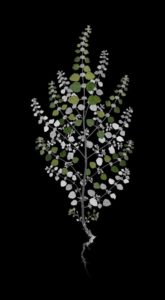
Bernnheim is excited to welcome one of 2016’s Artists in Residence, J.W. Fike, who arrives at Bernheim on August 1. Since 2008, Fike has been engaged in an epic quest to photograph and digitally illustrate a formidable collection of wild edible plants that spans the continental United States. He hopes this grand archive will highlight our country’s rich botanical holdings. He is creating specific exhibitions that connect viewers to their local, natural environments and currently holds a catalogue of over 100 specimens, with an emphasis on plants of the American West. While at Bernheim he hopes to significantly expand his portfolio to include specimens from our region. He has an MFA in Photography from Cranbrook Academy of Art, has taught numerous university level courses through out the United States and has been in many exhibition. We are thrilled to see what he discovers during his time at Bernheim.
Below is his artist statement, explaining his own work.
Within my system the plant is excavated, arranged in the studio, photographed, then illustrated digitally in such a way as to render the edible parts in color while the remaining parts, less emphatically, read as photograms. The plants in these images hover above an infinitely black space, referencing contact prints of botanical specimens from the dawn of photography and the collective unconscious. The 1:1 ratio of the photographs and high resolution color-coding speak to hyper-realistic, virtual and scientific modes of imaging. The photographs serve as an archive for an uncertain ecological future, reliable guide for foraging, and meditative symbols in communion with philosophical, spiritual and ecological truths. While this type of art may appear atavistic, its redeployment, in the precise moment of history, is vitally relevant to environmental issues. These edible plants grow all around us, in yards, alleys, ditches, and empty lots. Each testifies to our symbiotic evolution with all of life, and functions as both poetic metaphor and concrete proof of our intimate tether to the natural world. It is my hope that this art foments contemplative wonderment by offering viewers both information and insights that if realized kindle a reconnection to the natural world and a mystical counterbalance to scientific objectivism.
I envision this as a thoroughly inclusive catalogue that will result in hundreds of photographs. The aesthetic consciously combines empirical and visionary traditions by taking advantage of digital imaging’s capacity to create rhetorical shifts in the photograph. The resulting images are elegant, layered, historically aware and able to evoke mystery, amplify interconnectedness and offer a critique of classical taxonomy.
While this type of art may appear atavistic, its redeployment, in the precise moment of history, is vitally relevant to environmental issues. These edible plants grow all around us, in yards, alleys, ditches, and empty lots. Each testifies to our symbiotic evolution with all of life, and functions as both poetic metaphor and concrete proof of our intimate tether to the natural world. It is my hope that this art foments contemplative wonderment by offering viewers both information and insights that if realized kindle a reconnection to the natural world and a mystical counterbalance to scientific objectivism.
I envision this as a thoroughly inclusive catalogue that will result in hundreds of photographs. The aesthetic consciously combines empirical and visionary traditions by taking advantage of digital imaging’s capacity to create rhetorical shifts in the photograph. The resulting images are elegant, layered, historically aware and able to evoke mystery, amplify interconnectedness and offer a critique of classical taxonomy.
“To know the spirit of a place is to realize that you are a part of a part and that the whole is made of parts, each of which is a whole. You start with the part you are whole in.” Gary Snyder
Want to learn more about Mr. Fike’s work? Click here to read his LA Times profile.

